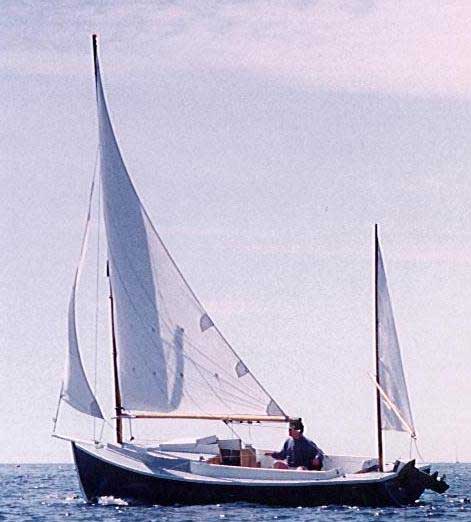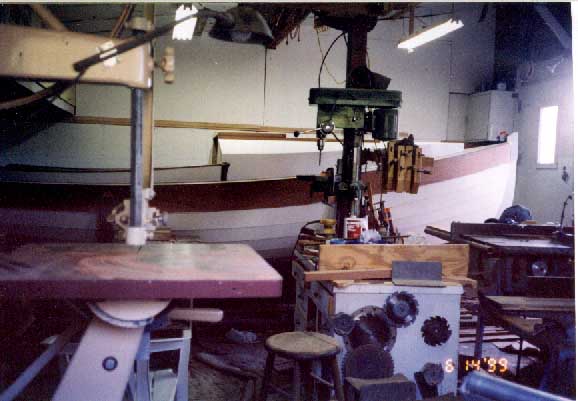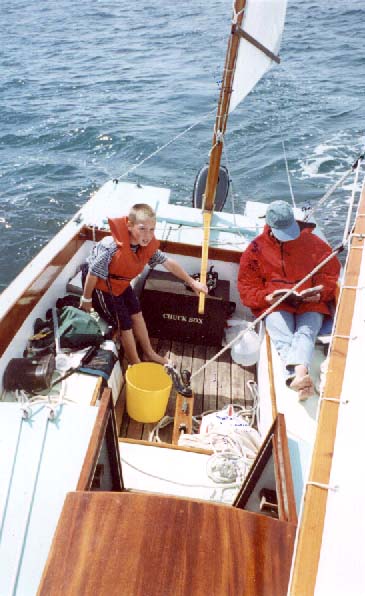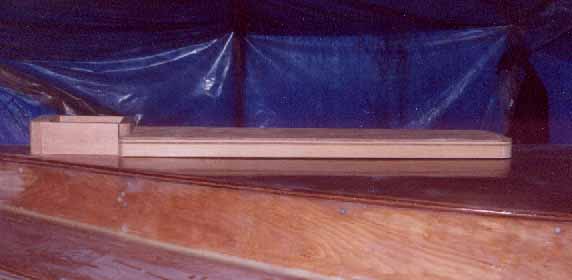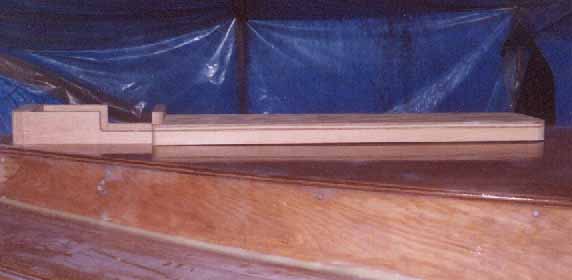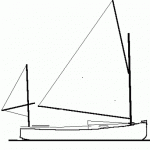 Chebacco News 28 – October 1999
Chebacco News 28 – October 1999
Kelani Rose is Launched!
Jim Slakov’s KELANI ROSE struts her stuff.
Jim Slakov, of Sechelt BC reports:
Well we launched the Kelani Rose (daughters Kelly and Annie and wife Rose) near the end of May, and have sailed about a dozen times since then. The weather in June was abysmal and not what we call summery at all, but July and August so far have been great! As I’m just learning to sail, we pick our days, and miss the windiest ones, perhaps saving them for later. One day the wind blew about 15 knots and that was very exiting, the boat took it well and didn’t show any signs of stress. I didn’t know about lifting the centre board when running with the wind…of course we’re commiting some of the classic errors for beginners . .. like getting into irons after a failed coming about, and ending up sailing backwards for a spell ( I know now to sheet the mizzen to correct that)… the transom does drag a bit sometimes, there is a 6 horse, 60 lb. outboard on the bracket, I think I’ l l throw a little more weight up front and see what happens, it’s not serious in any case and doesn’t seem to affect the performance… the Kelani Rose will self steer when the conditions are right, and some very experienced sailors have been aboard and complimented her on her handling ability. All in all I can’t think of anything I would change were I to build another, except to put a better quality line on the centre board ( I used a cheap 2nd hand prawn line and saved maybe 50 cents), so that will have to be removed in the fall.
There is a wooden boat show in Vancouver at the end of August, in which Kelani Rose will strut her stuff and hopefully do the name Chebacco proud! Am going to get some pictures taken under sail , soon I hope, and send them off to you… signing off for now, Jim Slakov… my email address is woodventures@uniserve.com
As it happens, Jim did do us proud and won first prize in the ‘Best New Construction’ category! Kelani Rose also got an excellent writeup in the ‘Coast Independent’ newspaper. Readers of Chebacco News will be interested to know that Jim made extensive use of cherry wood in her construction, and very beautiful it looks, too. The masts are of yellow cedar and the other spars of Douglas fir. He reports that the mast is up and the boat ready to go within 15 minutes of arriving at the slip.
Itchy and Scratchy goes from strength to strength:
Itchy and Scratchy . . .
Fraser Howell continues to experiment with the sails on his strip-built Chebacco Itchy and Scratchy:
Hi Bill
It is too windy to go out today. I’ll catch up on correspondence. Last time I wrote about the set of my mainsail, leech possibly too tight, too much depth for anything but light breezes. I tried a couple of things. I replaced the mast hoops with lashings that hold the luff closer to the mast, except at the tack. This pulled material out of the “pocket” and reduced the depth of the sail quite effectively. I also restrained the boom as if with a down haul to put more tension than the weight of the boom into the luff. That tension is set by the main hoist which has a 2:1 purchase.
These measures have flattened the sail, and reduced weather helm. I think it is faster, but I haven’t sailed in company, so cannot confirm it. I increasingly enjoy experimenting with the sail shape in different wind strengths and tacks. Varying tension on the foot, luff, the angle of the gaff, size and sheeting of the headsail. By the numbers Chebaccos should be fast, but I have not found that is always easy to achieve. Some days it is no fun at all, and my boat seems reluctant to do anything easily. Other times it is a joy to sail, balanced and fast.
Cheers;
Fraser
Jerome McIlvanie makes progress:
Jerome’s Chebacco . . .
Jerome McIlvanie of Yakima WA reports:
. . .I put an extra 1/4″ ply on the bottom, glassed, sanded and painted for six months. Turned it over, fitted out the inside, moved the cabin aft six inches, put an extra bulkhead clear across between aft cockpit and seat bulkhead. I enclosed it and built in an insulated ice box as shown in WoodenBoat magazine. It doubles as a seat also. I raised the sides of the cabin 2″ and put on 1″ or so more crown in the top. I used 2 layers of 1/4″ ply glued and screwed to 4 laminated bows out of long, thin 1 3/4″ square. I cut eh hole out for the hatch and used it for the sliding hatch. I glassed the top. For the centreboard and used 1 1/4″ thick black polyethylene. It’s tough but machines nicely and is a little heavier than the leaded ply CB.
Hopefully next year it will be in the water.
Another Epic Cruise in Lark
LARK heads north to Cape Cod . . .
Tim Smith of New York City reports:
I suppose a literal-minded person would say that our Chebacco cruising season stopped for the winter, in the sense that the boat was hauled and wrapped, and the children had a school year, and there was Christmas, and snow. But all that was really an interlude between voyages, one that gave us barely enough time to work on our wish list. Item one on the list was good bedding, so we bought two Coleman air mattresses and a battery-operated pump. Next we located a pre-fab galley box, with compartments to hold pots and pans and drawers for cutlery. I had thought for a while that a rudimentary electrical system would be nice, and lo and behold, there in the West Marine catalog was a 12-volt battery, sealed in a plastic case, with two ports for cigarette-lighter-style connectors. Turns out that it fits in the well beside the mizzen step; with an extension cord run into the cockpit, it can power the GPS, lights, VHF, what have you.
Next we ordered a new mizzen. The old one had tried to commit suicide at the mooring in a gale, when the clew, which had a bronze fitment on it, came loose and beat itself to pieces.
Then we decided we needed a tender, and so built an Auray Punt during the cold months. I picked the design because it looked good for t owing and could carry four, and promised to be easy to build. It went together with no surprises, though I made the botttom out of 3/8 inch ply instead of the 1/4-inch specified. Of course the punt wasn’ t quite finished by the time the provisioning season was over.
Our Chebacco, called Lark,went back in the water toward the end of June. It’ s an easy job for one person, now that the mast-stepping slot is installed and the trailer has extra bunks. I rigged a brailing line through the beehole in the mizzen mast to help keep the new sail secure: furled it by grabbing the clew and rolling it up into a sausage against the mast, then belayed it, and lashed the brailing line in a descending spiral around the whole works. It seemed tight, though the very top of the sail was too stiff to lie down properly. Left Lark on the mooring feeling pleased.
That night a storm blew in, and it stayed for the morning. I drove down to the dyke with my son just to have a look. The mizzen had stayed furled all right, but Mother of God – the wind had lifted the whole works, mast and sail, up out of the step and halfway out of the partner, and the rig was swinging around drunkenly, wedges scattered like broken teeth. We got the mess under control, my boy learning some brand new words along the way. Evidently the small stiff spot at the head of the sail had caught enough of the gale to pull everything loose. There is one other yawl in our local waters that has a sprit-rigged mizzen, and more than once I’ ve seen the sail flapping forlornly at the mooring after a big blow. Does this mean simply that there is room in one small town for two morons? Or is there a lost art of spritsail furling that other readers may know about? We addressed the problem by winding the mizzen around an d around the mast and cleating a line to the clew, which seemed to do the trick. I’ d love to hear what others have done.
Howling wind was a theme of the early part of the summer, and we had lots of practice sailing the boat single and double-reefed – a boon , actually, because we learned a lot about her limits. One fine blustery afternoon I had three experienced dinghy racers aboard and one very game novice, and we decided to leave one reef in when we should have had two. We sailed out into Nantucket Soun d into the teeth of a 20-knot southwest wind kicking up 4-to-6 foot waves. The boat was stable and fast; the sail was exhilarating, wet, and not too alarming. Crawling forward to secure the anchor on its sprit, I got a good look upward along the mast, and couldn’ t quite believe the bend it was taking. Under those conditions the rudder seemed small, but we were pushing it. One nice thing about this kind of sailing in the Chebacco, as opposed to a conventional cat: I find this boat much easier to jibe in a big wind. We used to dread the maneuver in a Marshall 22, but now don’ t give it a second thought, and that ‘ s a handy thing in a crowded harbor.
The strong southwest wind prevailed, but we were bent on cruising and constrained by a schedule, so one Frid ay morning in July we loaded our new gear aboard and took off, intending to head for Nantucket Island, about 25 miles to the south. We decided to tow a dinghy. Big mistake. The Auray Punt wasn’ t yet launched, so the dinghy we took along was an old family warhorse, a relatively heavy design by F. Spaulding Dunbar with little rocker and a lot of wetted surface. It towed nicely as we left the harbor, then slowed our progress perceptibly as we nosed out into the sound. Then we stopped thinking about it for a while because a quite amazing wind blew up and stayed up, making a wicked short chop against the falling tide. We weren’ t traveling anywhere far in those conditions, so we turned tail and ducked into the lee of some local barrier islands for a daysail.
Near sunset we anchored by the beach, spotted couple of guys digging clams, bought some, cooked them up with garlic and white wine, and ate them as the sun went down. The new air mattresses were a great success. With the cooler on one side of the centerboard trunk and the galley box on the other they were amply supported, and we slept snugly under the boom tent, kids in the cuddy. The next morning it was still blowing like hell. With a double reef in, we headed back out into the sound to see what progress we could make.
Towing the dinghy it was tough going to windward, wet and slow. I don’t recall what the currrent was doing, but the GPS said we were making little more than 2 or 3 m.p.h., and that was up hill and down dale. When we gave up at last and reached back for the harbor, our speed didn’ t improve much: I’ d guess that the tow cut our speed in half on all points of sail. “Maybe next time we should leave the dinghy behind and take advantage of the boat’ s sailing ability,” my wife suggested. I thought of some suggestions in return, but stifled them.
Three weeks later we had another stretch of vacation and another shot at a Nantucket trip. We got provisions together and waited for fair weather, which wasn’ t long coming. On a Friday morning with a 10-15 knot breeze we tucked in a reef and headed south – a glorious sail with the wind on the port quarter, the boat happy as a mallard. With the dinghy left at home on the beach, we made the trip in about five hours. The children played blackjack in the cuddy, declining to tell us how they had learned the game.
Nantucket is an island choking on its own wealth, a Yankee playland for the gilded age. Which means, among other things, that its harbor is jammed full of fabulous boats. As we were going into the harbormouth, Endeavor, the J-boat, was coming out. And once we were well inside it was like a crowded parking lot. We picked our way easily through the fleet, sailed up to a beach at the foot of Main Street, found room enough to swing among the Boston Whalers in a couple feet of water, and waded ashore. We spent the night with friends who have a house there.
Morning came, and the weather report was discouraging. The day itself promised fair weather with a Northeast breeze, but the next couple of days were to be gray and wet. Rather than turn the children off to cruising, we decided to head for home. We wandered down to the beach – steps ahead of Bill and Hillary Clinton, in town for a fund-raiser – and found Lark aground. She wasn’ t hard aground, just stuck in the sand, bow afloat, a couple of extra inches of waterline showing at the stern. But the tide was falling, and would be for another four hours. My wife, my son and I stood backwards against the transom and heaved. Nothing. We got our hands under her, lifted, and heaved some more. She moved. Four more good grunts and she was afloat.
It was a long close reach home, a sail of about six hours in a 10-12 knot breeze and bright sunshine. The kids tried their hands at sailing. The boat hummed along; the trip was sublime. For the record, we did, finally, get the Auray Punt painted and launched. She’ s the fourth Bolger in our fleet: besides Lark there’ s a long Diablo and an Elegant Punt. The Auray Punt is a really nice rowboat, swift and steady. I’ d say she’ s a little bit less stylish in three dimensions than in two, although when she’ s coming at you head-on, showing her flare, she’ s got real panache. Towed behind the Diablo, she tracked nicely. She’ s light, so maybe next year we’ ll try towing her somewhere with the Chebacco. Or maybe not. Lark has a big heart, but she’ s no tugboat. Which means, I suppose, that my wife was right. Happily, she doesn’ t know how to find this URL, so she’ ll never know.
Tim Smith’s stretched Diablo and Auray Punt . . .
Jamie Orr and Bill Samson talk boats
Jamie Orr of Victoria BC was visiting Scotland in August and dropped by to see Bill Samson and to go for a sail in Sylvester. The ‘sail’ was more of a ‘motor’ due to lack of wind, but we O.D.’ed on boat talk and had a great time. Jamie’s sheet ply Chebacco is nearing completion and should be in the water next year. Jamie left these photos of his mast slot, which has a neat sliding cover:
Cover closed . . .
and open.
New email address and URL for Chebacco News:
Bill Samson can now be contacted on : bill.samson@tesco.net
Chebacco News is at http://members.xoom.com/billsamson
Snail mail to Bill Samson, 88 Grove Road, Broughty Ferry, Dundee DD5 1LB, Scotland.


